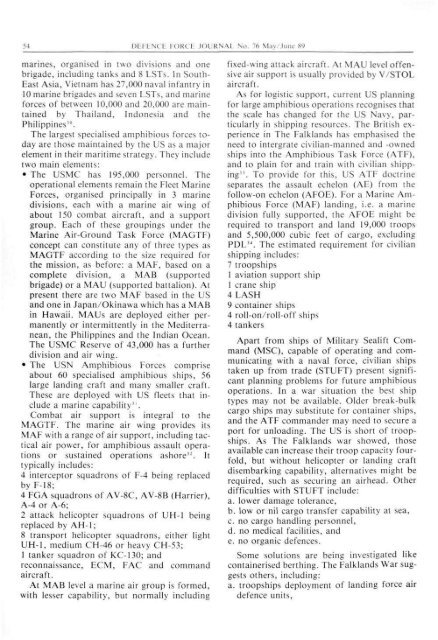ISSUE 76 : May/Jun - 1989 - Australian Defence Force Journal
ISSUE 76 : May/Jun - 1989 - Australian Defence Force Journal
ISSUE 76 : May/Jun - 1989 - Australian Defence Force Journal
- No tags were found...
You also want an ePaper? Increase the reach of your titles
YUMPU automatically turns print PDFs into web optimized ePapers that Google loves.
; 4 DEFENCE FORCE JOURNAL No. <strong>76</strong> <strong>May</strong>/<strong>Jun</strong>e 89marines, organised in two divisions and onebrigade, including tanks and 8 LSTs. In South-East Asia, Vietnam has 27,000 naval infantry in10 marine brigades and seven LSTs, and marineforces of between 10,000 and 20,000 are maintainedby Thailand, Indonesia and thePhilippines 30 .The largest specialised amphibious forces todayare those maintained by the US as a majorelement in their maritime strategy. They includetwo main elements:• The USMC has 195,000 personnel. Theoperational elements remain the Fleet Marine<strong>Force</strong>s, organised principally in 3 marinedivisions, each with a marine air wing ofabout 150 combat aircraft, and a supportgroup. Each of these groupings under theMarine Air-Ground Task <strong>Force</strong> (MAGTF)concept can constitute any of three types asMAGTF according to the size required forthe mission, as before: a MAF, based on acomplete division, a MAB (supportedbrigade) or a MAU (supported battalion). Atpresent there are two MAF based in the USand one in Japan/Okinawa which has a MABin Hawaii. MAUs are deployed either permanentlyor intermittently in the Mediterranean,the Philippines and the Indian Ocean.The USMC Reserve of 43,000 has a furtherdivision and air wing.• The USN Amphibious <strong>Force</strong>s compriseabout 60 specialised amphibious ships, 56large landing craft and many smaller craft.These are deployed with US fleets that includea marine capability".Combat air support is integral to theMAGTF. The marine air wing provides itsMAF with a range of air support, including tacticalair power, for amphibious assault operationsor sustained operations ashore 32 . Ittypically includes:4 interceptor squadrons of F-4 being replacedby F-18;4 FGA squadrons of AV-8C, AV-8B (Harrier),A-4 or A-6;2 attack helicopter squadrons of UH-1 beingreplaced by AH-1;8 transport helicopter squadrons, either lightUH-1, medium CH-46 or heavy CH-53;1 tanker squadron of KC-130; andreconnaissance, ECM, FAC and commandaircraft.At MAB level a marine air group is formed,with lesser capability, but normally includingfixed-wing attack aircraft. At MAU level offensiveair support is usually provided by V/STOLaircraft.As for logistic support, current US planningfor large amphibious operations recognises thatthe scale has changed for the US Navy, particularlyin shipping resources. The British experiencein The Falklands has emphasised theneed to intergrate civilian-manned and -ownedships into the Amphibious Task <strong>Force</strong> (ATF),and to plain for and train with civilian shipping'3 . To provide for this, US ATF doctrineseparates the assault echelon (AE) from thefollow-on echelon (AFOE). For a Marine Amphibious<strong>Force</strong> (MAF) landing, i.e. a marinedivision fully supported, the AFOE might berequired to transport and land 19,000 troopsand 5,500,000 cubic feet of cargo, excludingPDL' 4 . The estimated requirement for civilianshipping includes:7 troopships1 aviation support ship1 crane ship4 LASH9 container ships4 roll-on/roll-off ships4 tankersApart from ships of Military Sealift Command(MSC), capable of operating and communicatingwith a naval force, civilian shipstaken up from trade (STUFT) present significantplanning problems for future amphibiousoperations. In a war situation the best shiptypes may not be available. Older break-bulkcargo ships may substitute for container ships,and the ATF commander may need to secure aport for unloading. The US is short of troopships.As The Falklands war showed, thoseavailable can increase their troop capacity fourfold,but without helicopter or landing craftdisembarking capability, alternatives might berequired, such as securing an airhead. Otherdifficulties with STUFT include:a. lower damage tolerance,b. low or nil cargo transfer capability at sea,c. no cargo handling personnel,d. no medical facilities, ande. no organic defences.Some solutions are being investigated likecontainerised berthing. The Falklands War suggestsothers, including:a. troopships deployment of landing force airdefence units,
















